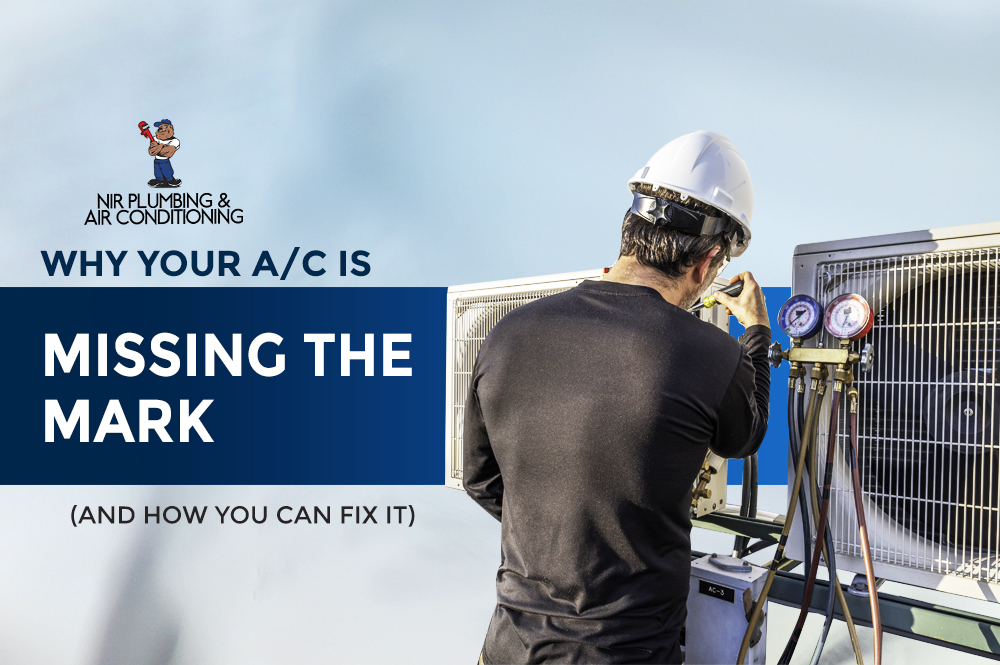Overview: It’s summer and your A/C is blowing out hot air — what’s the problem? Let’s talk potential dirt blockage, compressor, and other “cool” things.
I once owned a car with an air conditioner that blew hot air. Let’s just say during the peak of summer, I was not a happy driver. But at least my home A/C was working well! Now imagine your home air conditioner blowing out hot air.
Sweating through a sleepless night or slogging through the heat of a sweltering July afternoon — I’m sure we’ve all been there at least once. And we can all agree that summer simply is not the time for A/Cs to blow hot air (considering most people’s day-to-day to-do list consists of simply staying cool).
So, if your central air conditioner isn’t cooling your home down to the set temperature on your thermostat, here are some quick troubleshooting tips you can try to do before you settle on calling in a professional to repair your AC. Check to see if:
- Your thermostat is switched to ON
- Your air filter is dirty
- Your outside unit is dirty
- Your circuit breaker is tripped
If you’ve checked for the problems above but your A/C still isn’t cooling down the house, you probably have a larger problem that requires a professional. Bu the tricky part is the possibility that nothing’s actually “wrong” with your AC — you might just be pushing the limitations of your system. That’s why we’re giving professional HVAC guidance to help you better determine the situation.
Why your air conditioner isn’t blowing out cool air and what to do
If your air conditioner will turn on, and your thermostat is set properly, but your system is not cooling, you may have a dirty or blocked air condenser. We’ve mentioned this earlier that you should first check the outside unit for dirt.
-
Clean around and remove any debris or weeds that are blocking air circulation.
A lot of times, we find the filter is dirty, and when it restricts the air to the evaporator coil, the coil can freeze. If you have pets or run your a/c often, you may need to change your filter more frequently. A good test is to pull your filter out and check if you can see through it.
-
Check your filter and make sure it is clean.
If your air conditioner is still not cooling air, you may have a problem with your compressor or refrigerant and will need to contact a professional. Some issues that might need to be addressed:
Problem #1: Refrigerant leak
In the beginning of this article, I talked about my car with the A/C that only blew out hot hair — this turned out to be a refrigerant problem. And this could also affect your home unit.
Refrigerant is the liquid/gas responsible for absorbing heat from your home’s air. If your AC system is low on refrigerant, it won’t cool your home as well as it normally would.
Here’s the thing: Refrigerant runs in a closed loop through your system. So, if your system is low on refrigerant, it means you have a leak. Other signs you have a refrigerant leak include:
-
-
Frozen refrigerant line on your outdoor unit (you’ll see the ice buildup)
-
You feel warm air from your AC vents
-
You hear a hissing/bubbling noise near the AC (this indicates a significant leak)
-
If you think you have a refrigerant leak, you should contact a professional to repair the leak and add refrigerant to your system. Refrigerant can be harmful if handled incorrectly, so it’s best to leave that to a pro.
Problem #2: Leaky ducts
If you have leaks in your ductwork, the hot, unconditioned air of your attic can seep into your ducts, increasing the temperature of the air that is pushed out from your AC vents. Unfortunately, duct leaks can be hard to detect since ducts are hidden in your attic. Signs you have leaky ducts include:
-
-
Higher-than-normal energy bills
-
You have rooms that don’t cool well
-
Your home is unusually dusty (from the dust in your attic)
-
If you have leaky ducts, you’ll need to contact a professional to seal your ducts with mastic sealant or metal tape.
Problem #3: A bad compressor
The compressor is the core of your AC system. It circulates the refrigerant that removes heat from your home’s air and dumps it outside. If your compressor isn’t pumping refrigerant like it should, your air conditioner won’t cool your home well.
The bad news: If there’s a problem with the compressor, you’ll most likely need to replace it (vs just repair it). Compressors are “hermetically sealed”, which means you can’t open them up to repair a single component.
Unfortunately, the compressor is the most expensive part of the AC. So unless your manufacturer warranty is still valid, you might be better off investing in a new unit.
Problem #4: Evaporator coil is frozen
The indoor component of your central air conditioning system will include an evaporator coil. If your indoor unit is a furnace, the evaporator coil sits in its own cabinet, outside the furnace. If the indoor unit is a fan coil (typically as part of a heat pump system), the evaporator coil sits inside the fan coil cabinet.
Warm indoor air passes through the evaporator coil where heat energy and humidity are removed from the air. Cooler, more comfortable air is then circulated back to your home. Signs of a frozen evaporator coil include:
-
-
Frost forming on the copper refrigerant tubing coming from the coil cabinet
-
Inadequate cooling
-
Higher utility bills
-
Excessive condensate drainage near your indoor unit
-
In extreme cases, frost forming on exterior refrigerant tubing or the outdoor unit
-
Because accessing the evaporator coil is difficult, resolving issues associated with a frozen evaporator coil are best handled by an HVAC professional.
Related article(s): My AC Is Running But Not Cooling the House
Your air conditioner isn’t adequately cooling your home
If your air conditioner is on and set properly but is still not cooling your home to your standards, you may have a unit that is not sized appropriately for your home.
Keep in mind that your system should be sized to keep your home cool on the average summer day. The average system should be able to maintain a 20-25 degree temperature difference between the outdoor and indoor temperature. In other words, your air conditioner is not designed to keep your home at 68 degrees when it is 95 degrees outside.
Under moderate conditions, you may not notice any issues with an undersized air conditioner. However, as temperatures rise outside, your AC may run for long periods of time and struggle to keep you cool.
Determining the size of your AC unit
You might be able to determine the size of your AC unit from the rating info on the cabinet panel, but it will be difficult to determine whether it is the “right size” for your home. There are a number of factors involved in sizing a system for your home, including
-
square footage
-
quality of construction and insulation
-
local climate
If your system is undersized, it may be possible to provide cooling in problem areas by adding a ductless unit to help out in “hot spots”. Or, it may be better to replace the system with one that is correctly sized. The best way to address sizing issues is to contact a qualified HVAC professional who can accurately assess your home and its optimum cooling capacity.
Related article(s): How to fix 3 common problems with your air conditioner; Why is My Air Conditioner Not Cooling?


